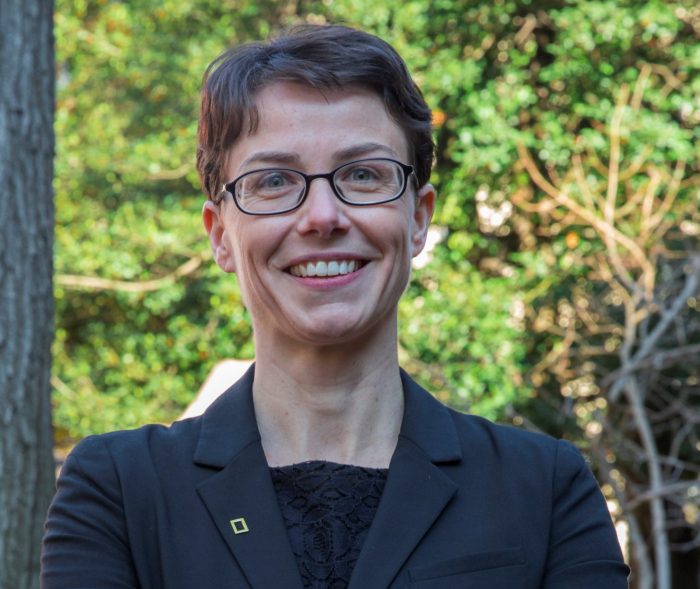SBU’s Heather Lynch receives Pew Fellowship in marine conservation
By Daniel Dunaief
To borrow from the Pink song in the movie Happy Feet, the Pew Trusts for Marine Conservation recently delivered “something good” to Stony Brook University’s Heather Lynch.
Endowed chair for ecology and evolution at Stony Brook University’s Institute for Advanced Computational Science, Lynch was selected as one of six Pew Fellows in Marine Conservation.
Lynch, who uses a host of tools including physics and satellite imagery to study penguin populations in Antarctica and associated island groups including in South Georgia and the South Sandwich Islands, is one of six international recipients of the 2022 fellowship, which includes $150,000 over three years, and is a mid-career prize.
Lynch plans to use the funds to chronicle species health in the macaroni and king penguin and forecast risks to Antarctica’s penguin populations.
Lynch’s work is “really important,” said Claire Christian, Executive Director of the Antarctic and Southern Ocean Coalition (ASOC), who nominated Lynch for the fellowship. Lynch provides the kind of information “we need to make effective decisions about protecting Antarctica.”
Christian, who has known Lynch for about five years, said Lynch’s consistent commitment helps “provide a broader picture of what’s happening down there over a longer time frame.”
Christian is particularly pleased that Lynch’s work in the Antarctic brings necessary attention to the region, even though “it’s far away at the end of the world,” she said. “People understand that [the Antarctic] is worth investing time and resources into studying.”
The Pew Fellows Program in Marine Conservation provides recipients with an opportunity to interact with other winners and alumni. This year, the Pew Trust received over 50 nominees.
Past honorees at Stony Brook University include Endowed Professor of Ocean Conservation Sciences at the School of Marine and Atmospheric Science Ellen Pikitch and Endowed Research Chair for Nature and Humanity Carl Safina.
Jane Lubchenco, who won a Pew Fellowship in marine conservation in the 1992, was the first woman to lead the National Oceanographic and Atmospheric Administration and is the current Deputy Director for Climate and Environment in the White House.
Rebecca Goldburg, Director of Environmental Sciences at the Pew Charitable Trusts, appreciates the mixture of high-level research Lynch produces and the application of her discoveries to conservation and added that Lynch has “outstanding scientific achievement that is well-integrated into decision making.”
Climate change
While researchers haven’t broadly chronicled the movement of macaroni penguins into the Antarctic, Lynch anticipates that climate change would draw them into the Antarctic.
“My hope is that a focus on macaroni penguin census data will illuminate their trends,” she explained in an email.
King penguins, meanwhile, have recently arrived in the Antarctic. The presence of king penguins would represent a turning point for Lynch, as they would suggest that the Antarctic is starting to show ecological similarities with the sub-Antarctic.
King penguins have attempted to breed on Elephant Island, which is about 800 miles from their typical habitat in South Georgia. While this species of penguin has traveled this distance in prior years, their decision to settle and try to raise chicks, which they haven’t successfully done, is “new and ecologically interesting,” Lynch explained.
Lynch suggested such a geographic expansion is rare because these birds are long-lived and an established pair will breed in the same location for years. Even in young individuals traveling to new territories, the rate of range shift is slow and hard to track.
“The movement of king penguins into Antarctica is exactly what would have been predicted and so it is an exciting (if, from a climate perspective, disturbing) time to be watching this all unfold,” she said.
King penguins can form large colonies, which could, over the course of a longer period of time, create competition for space with chinstraps. Lynch suggested that the region could be in the early days of an ecologically important event.
Where’s Waldo?
As for macaroni penguins, whose stories about how they got their name include one involving a sailor slang for men who dressed in bright colors, they have frequently been the “Where’s Waldo?” of what Lynch does, she said, as she encounters them by chance in a colony of another species.
She is pulling together several decades of offhand notes about her findings on macaronis to track them systematically. She believes collecting information about populations of macaroni and king penguins in Antarctica is going to be informative.
In analyzing penguin populations across species, Lynch plans to take the kind of approach portfolio managers apply when they consider where to focus their attention.
A mutual fund manager with a large percentage of the value of the fund linked to changes in the stock price of Apple would likely track the earnings of the company and its share price more closely than stocks in which she has smaller holdings or whose values don’t fluctuate much.
For penguins, Lynch suggested that scientists and conservationists may “need to understand those colonies, and there may not be that many, that contain a large percentage of the world’s population,” she said.
For a long time, researchers have focused on colonies that were easier to study because they were small and close by. “I don’t think we can justify that approach anymore,” Lynch said.
Picking penguin spots
Goldburg appreciates Lynch’s framework for penguin conservation.
Lynch will address the “key penguin colonies,” some of which are contributing disproportionately to the risk of penguin declines, Goldburg said. This approach will enable conservationists to monitor important sites because they “can’t do everything.”
Understanding penguin populations goes beyond a simple rule that more of any population is necessarily better. Major increases or decreases should be cause for concern because they reflect shifts in the functioning of the ecosystem, she explained.
Christian is confident the work Lynch does will provide policy makers with key information.
“Her work is really important and it deserves to have a lot of visibility and funding,” Christian said. “Without understanding what’s happening to species that are living down there, we can’t” design effective strategies to protect them and their ecosystems.
Lynch provides the kind of information necessary to “make effective decisions about protecting Antarctica,” Christian added.







